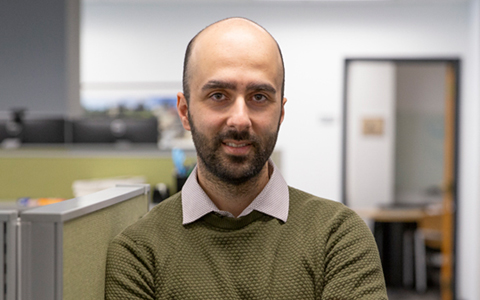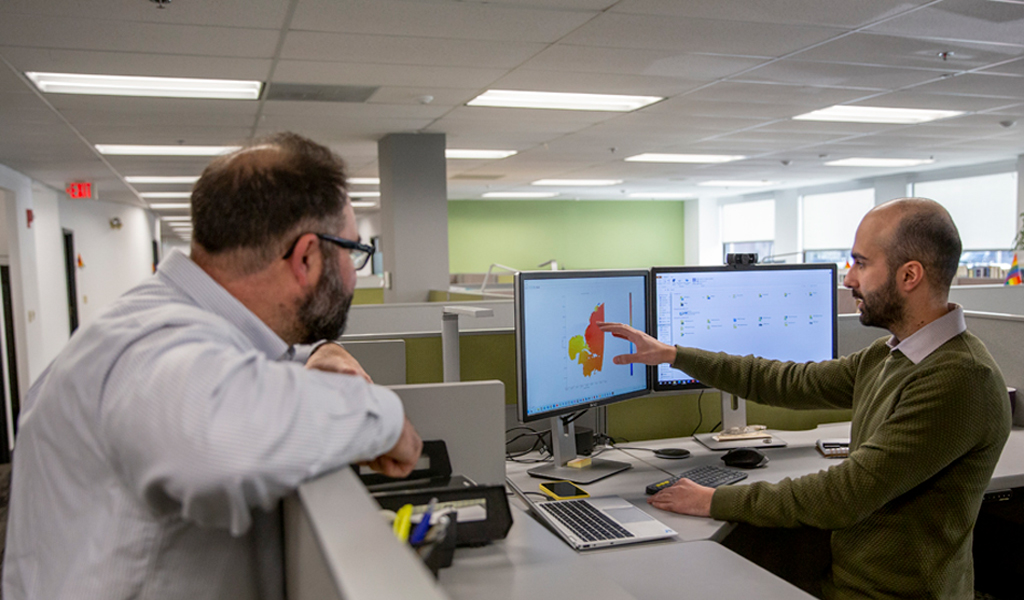
VHB continues to strengthen its decades-long partnership with Northeastern University in Boston, most recently by sponsoring a PhD student to bring leading-edge academic tools and concepts to our business through the university’s new LEADERs Program. Reza Salatin joined VHB’s Watertown team in January and will spend the spring semester working with Jake San Antonio, Chief Engineer for Water Resources, and other VHBers in advancing our ability to plan and design resilient projects for our clients that account for coastal changes as threats from global climate change increase.
“It’s wonderful to have Reza on our team this semester,” said Jake. “He brings valuable technical skills and a strong engineering background that are advancing our ability to support our clients on complex infrastructure and water resources projects. He’s also a great colleague and collaborator—I know my team and I will all learn from working with him.”
We sat down with Reza to learn more about his work and how it will help VHB serve our clients.
VHB: First, welcome to VHB! We’re so glad to have you. You hold a master’s degree in structural engineering from Middle East Technical University in Turkey, and you’re a PhD candidate in Coastal Engineering. Can you tell us more about your academic interests?
Reza: My academic interest has been on integrating computer models and data analysis to solve real-world engineering problems. I have worked on a variety of projects, from designing a 350-ton capacity onshore drilling rig with minimum possible weight, to studying the uplift pressure of waves on bridge decks, and investigating the nearshore processes that erode shorelines and put communities at risk. More recently, I am using computer vision techniques integrated with artificial intelligence to study the longshore variation of wave runup.
VHB: As a doctoral student, what brought you to VHB?
Reza: PhD research projects are often theoretical and focused on long-term discovery rather than more immediate commercial applications. At the same time, industry is generally behind academia in using state-of-the-art tools. The LEADERs Program at Northeastern brings academia and the business world together, to learn from each other. So I’m here at VHB to see how my work can be applied to problems facing VHB clients, and also to learn more about the needs of communities.
VHB: What kinds of challenges are you working to solve?
Reza: I’m working on developing a model that VHB can use to simulate coastal flooding. We know that sea levels are rising and storm surge will likely intensify. How can we design solutions to protect coastal communities if we don’t understand the problems we will be facing, say, 50–100 years from now? By simulating conditions that don’t exist yet, these models will help us understand vulnerabilities and design resilient infrastructure that will mitigate and account for these future vulnerabilities.
VHB: What kind of tools are you using for this work?
Reza: In coastal engineering, we use many different models, developed by both companies and academic groups. Each model does something specialized. Some models that I’m using in my PhD program can simulate very small areas and output results by centimeter. Other models simulate the whole world. So it’s important to choose the right model based on the needed application.
At VHB, I’m working to combine two well-known open source models, SWAN and Delft3D, so that VHB will have its own proprietary, probabilistic model that will allow us to simulate flooding at a fine scale in the greater Boston area. We want to understand what flooding will look like with different offshore wave heights, tidal conditions, sea levels, and so on. Then we can ask, OK, what’s the best way to protect coastal cities and their shorelines?
VHB: That’s a great question—what is the best way to protect coastal cities? Is it even possible?
Reza: Yes, I think it’s possible, although traditional methods are not always the best solution. For example, some cities have spent millions on seawalls and still have flooding.
In one of my PhD projects, I studied constructed oyster reefs, which I learned VHB also has experience with. Scientists put concrete blocks in the nearshore zone and, given the appropriate conditions, oyster larvae will settle on them. As the oysters grow, they can actually keep pace with sea level rise. These reefs attenuate wave energy and reduce shoreline erosion as a long-term solution. This is just one example. We can come up with other innovative solutions, but first we need to study the problem with modeling and other tools.
VHB: On a personal note, you’re a long way from home. Has that been challenging?
Reza: I’m very happy to be studying here, but it’s hard to be away from my family. I haven’t been able to go home to Iran in five years because of the political issues. You lose something, you gain something. We hope things will change in Iran. I’m fortunate to have so many opportunities here, and I’m excited to be working with Jake and other people at VHB.
VHB: Well we’re excited to have you—thanks very much for speaking with us and good luck with your model!

